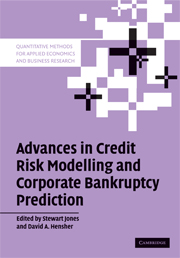Book contents
- Frontmatter
- Contents
- List of figures
- List of tables
- List of contributors
- Introduction
- 1 A statistical model for credit scoring
- 2 Mixed logit and error component models of corporate insolvency and bankruptcy risk
- 3 An evaluation of open- and closed-form distress prediction models: The nested logit and latent class models
- 4 Survival analysis and omitted dividends
- 5 Non-parametric methods for credit risk analysis: Neural networks and recursive partitioning techniques
- 6 Bankruptcy prediction and structural credit risk models
- 7 Default recovery rates and LGD in credit risk modelling and practice: An updated review of the literature and empirical evidence
- 8 Credit derivatives: Current practices and controversies
- 9 Local government distress in Australia: A latent class regression analysis
- 10 A belief-function perspective to credit risk assessments
- Index
- References
4 - Survival analysis and omitted dividends
Published online by Cambridge University Press: 11 June 2010
- Frontmatter
- Contents
- List of figures
- List of tables
- List of contributors
- Introduction
- 1 A statistical model for credit scoring
- 2 Mixed logit and error component models of corporate insolvency and bankruptcy risk
- 3 An evaluation of open- and closed-form distress prediction models: The nested logit and latent class models
- 4 Survival analysis and omitted dividends
- 5 Non-parametric methods for credit risk analysis: Neural networks and recursive partitioning techniques
- 6 Bankruptcy prediction and structural credit risk models
- 7 Default recovery rates and LGD in credit risk modelling and practice: An updated review of the literature and empirical evidence
- 8 Credit derivatives: Current practices and controversies
- 9 Local government distress in Australia: A latent class regression analysis
- 10 A belief-function perspective to credit risk assessments
- Index
- References
Summary
Introduction
Survival analysis is a set of statistical methods designed for the analysis of time to event data. Its origins can be traced back to interests in population mortality in the late 1600s (e.g., see Graunt 1676) and its designation as ‘survival analysis’ reflects early applications in demography and biological science predominantly concerned with the ability of individuals or organisms to survive a given period of time until death. Although the use of survival analysis in the social sciences is fairly recent, the last ten years have seen an increase in the use of the method in economics-based research as researchers have begun to develop an interest in the duration of time that precedes the occurrence of an event.
Survival analysis models are concerned with examining the length of the time interval (‘duration’) between transition states (Blossfeld et al. 1989). The time interval is defined by an origin state and a destination state and the transition between the states is marked by the occurrence of an event during the observation period. An event is a qualitative change that occurs to an individual, organization, political party, society, or other collective (hereafter ‘individual’) as it changes from one discrete state to another discrete state as the result of a substantive process. The majority of survival analysis models examine the occurrence of a single event that transitions an individual across discrete states although there are models in which the event represents a transition to one of several states, repeated transitions from states, or where the event occurs many times.
- Type
- Chapter
- Information
- Publisher: Cambridge University PressPrint publication year: 2008



